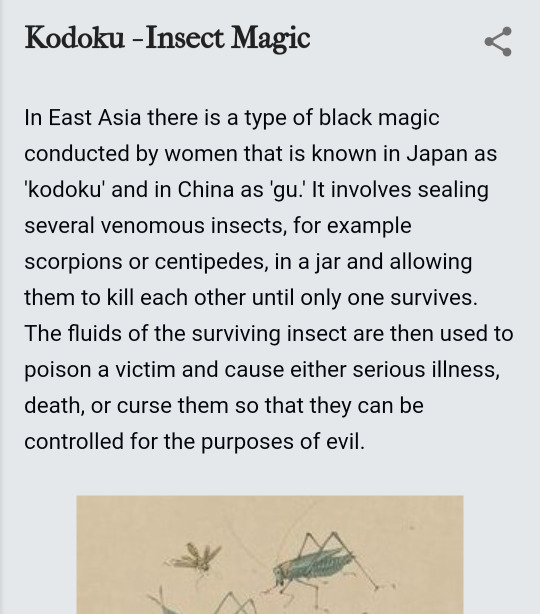mid 20s | they/it/he pronouns | queer | eclectic witch | USA got locked out of my last blog so trying to rebuild from the ground up i guess
Don't wanna be here? Send us removal request.
Text
Beginner Class - Session 1
Getting Your Feet Wet
___
By KB
I'm going to be uploading sessions from a class I taught this spring here ♡
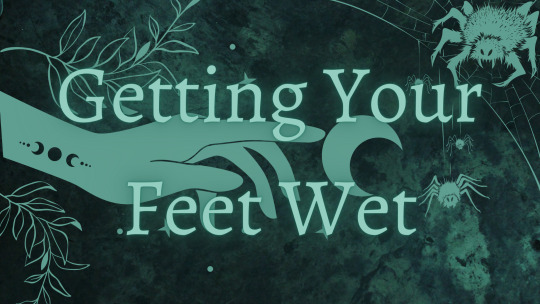
INTRODUCTION
So, you're interested in learning about the world of witchcraft, the occult, or maybe just the spirit world. Whatever may bring you here, welcome to the first study session to our beginner's course. Today, we're going to be talking about how to actually start your own practice in order for you to discover your own unique path. First and foremost, throw everything that you have seen in movies and most of what you think you know in the garbage. The metaphysical world has been misunderstood and misportrayed for years. With that being said, let's look into some of the ways that you can begin your own practice and avoid burnout from overwhelming emotions. I encourage you search for other methods outside of what is mentioned here if you have the energy to do so.
First & Foremost - Research!
We already get it, ugh! This is actually the most crucial aspect of learning, despite what you're probably thinking. The toughest part of conducting research isn't necessarily doing it; it's determining out where to start. I recommend all of you to begin your own research into the craft in your own time, as it will be a full proof method of finding out what you're most interested in learning, which will ultimately help form a foundation for your path. Here are some places to begin your research. Of course, these are only a few suggestions and I encourage you to look outside of this list for other things to include in your research! Remember, this is not mandatory, but it would definitely be beneficial for you if you were to go ahead and take a look into some of these.
♡ The History of Witchcraft
♡ Energy (sensing, raising, manipulation, etc)
♡ Grounding
♡ Meditation
♡ Intention
♡ Intuition
♡ Altars
♡ Correspondences
♡ Candles
♡ Crystals
♡ Cleansing
♡ Spirits
♡ Deities
♡ Mythology
♡ Entities
♡ The Fae
♡ Moon Phases
♡ Divination
♡ Pagan Holidays
♡ Self-Awareness
♡ Shadow Work
♡ Zodiac Signs
♡ Spellcasting
Now that we know what to research and have a few beginning points, how do we go about carrying out the study and ensuring the information we have gathered is correct? Unfortunately, in this day and age, misinformation is pervasive in our everyday lives, making it difficult to distinguish between what is true and what is fabricated. Turn on your witch brain and never be scared to cross-reference your knowledge.
Before we continue to the following section, one more thing. Please, when searching social media sites for spell and ritual advice, use reason and a careful eye. Due to the rise in popularity of witchcraft, many bloggers are generating revenue by creating trendy works of art that adhere to the "witch aesthetic". Despite being visually appealing, these lack crucial substance, especially for novices. Let's look at some examples of the current spell jar trends. The elements are listed, yes, but they don't explain why you should add them or how to raise and direct the energy so that your spell will manifest and produce tangible effects. Always remember that if it doesn't include specifics about programming, energy, or correspondences, it's most likely just trendy wishcraft and not the real deal.
Class Dictionary
Aʟᴄʜᴇᴍʏ - a form of chemistry and speculative philosophy practiced in the Middle Ages and the Renaissance and concerned principally with discovering methods for transmuting baser metals into gold and with finding a universal solvent and an elixir of life. any magical power or process of transmuting a common substance, usually of little value, into a substance of great value. any seemingly magical process of transforming or combining elements into something new
Asᴛʀᴏʟᴏɢʏ - the divination of the supposed influences of the stars and planets on human affairs and terrestrial events by their positions and aspects
Aᴛʜᴀᴍᴇ - A ceremonial pointed knife or dagger, used especially in Wicca and other neopagan traditions and typically having a black handle with magical symbols on it.
Aᴜʀᴀ - an energy field that is held to emanate from a living being
Bᴀɴɪsʜɪɴɢ - banishing refers to one or more rituals intended to remove non-physical influences ranging from spirits to negative influences
Bɪʙʟɪᴏᴍᴀɴᴄʏ - divination by means of a book, especially the Bible, opened at random to some verse or passage, which is then interpreted.
Cᴇʀᴇᴍᴏɴɪᴀʟ ᴍᴀɢɪᴄ - encompasses a wide variety of rituals of magic. The works included are characterized by ceremony and numerous requisite accessories to aid the practitioner. It can be seen as an extension of ritual magic, and in most cases synonymous with it.
Cʜᴀʟɪᴄᴇ - a footed cup intended to hold a drink. In religious practice, a chalice is often used for drinking during a ceremony or may carry a certain symbolic meaning.
Cʟᴀɪʀᴀᴜᴅɪᴇɴᴄᴇ - Act of hearing, or the ability to hear, sounds not normally audible; -- usually claimed as a special faculty of spiritualistic mediums, or the like.
Cʟᴀɪʀsᴇɴᴛɪᴇɴᴄᴇ - the ability to sense the past, present, or future physical and emotional states of others without the standard five senses — smell, vision, touch, hearing, and taste.
Cʟᴀɪʀᴠᴏʏᴀɴᴄᴇ - knowledge of information not necessarily known to any other person, not obtained by ordinary channels of perceiving or reasoning—thus a form of extrasensory perception
Cʟᴇᴀɴsɪɴɢ - to metaphysically rid the environment of unwanted energies or entities
Cᴏʟᴏʀ Tʜᴇʀᴀᴘʏ - based on the idea that color and colored lights can help treat physical or mental health. According to this idea, they cause subtle changes in our moods and biology.
Cᴏɴᴊᴜʀᴀᴛɪᴏɴ - the evocation of spirits or other supernatural entities or a the raising of energy
Cᴏᴠᴇɴ - is a group or gathering of witches.
Dᴇᴍᴏɴᴏʟᴏɢʏ - Demonology is the study of demons within religious belief and myth. Depending on context, it can refer to studies within theology, religious doctrine, or occultism
Dɪᴠɪɴᴀᴛɪᴏɴ - Divination is the attempt to gain insight into a question or situation by way of an occultic, standardized process or ritual.
Dʀᴜɪᴅɪsᴍ - A druid was a member of the high-ranking class in ancient Celtic cultures. Druids were religious leaders as well as legal authorities, adjudicators, lorekeepers, medical professionals and political advisors. Druids left no written accounts.
Eʟᴇᴍᴇɴᴛᴀʟ - In certain occult systems, an inhabitant of one of the four elements, especially any of the beings described by Paracelsus as intermediate in corporeality between humans and spirits.
Eɴᴇʀɢʏ Mᴀɴɪᴘᴜʟᴀᴛɪᴏɴ - Energy Manipulation is the ability to generate, control, and manipulate various forms of energy.
Eɴᴇʀɢʏ Sᴇɴsɪɴɢ - the ability to sense and perceive shifting metaphysical waves
Esᴏᴛᴇʀɪᴄ - confined to and understandable by only an enlightened inner circle
Eᴠᴏᴄᴀᴛɪᴏɴ - Evocation is the act of evoking, calling upon, or summoning a spirit, demon, deity or other supernatural agents, in the Western mystery tradition.
Fᴀᴍɪʟɪᴀʀs - the double, the alter ego, of an individual. It does not look like the individual concerned. Even though it may have an independent life of its own, it remains closely linked to the individual. sometimes elemental spirits.
Gᴇᴍᴀᴛʀɪᴀ - the practice of assigning a numerical value to a name, word or phrase according to an alphanumeric cipher. A single word can yield several values depending on the cipher which is used.
Gᴇᴏᴍᴀɴᴄʏ - a method of divination that interprets markings on the ground or the patterns formed by tossed handfuls of soil, rocks, or sand
Gɴᴏsɪs - it signifies a spiritual knowledge or insight into humanity's real nature as divine, leading to the deliverance of the divine spark within humanity from the constraints of earthly existence
Gᴏᴇᴛɪᴀ - a practice which involves invoking angels and demons
Gʀɪᴍᴏɪʀᴇ - is a textbook of magic, typically including instructions on how to create magical objects like talismans and amulets, how to perform magical spells, charms and divination, and how to summon or invoke supernatural entities such as angels, spirits, deities, and demons
Gʀᴏᴜɴᴅɪɴɢ - the practice of physically connecting oneself as closely as possible to the Earth in order to obtain earth energy
Hᴇʀᴍᴇᴛɪᴄɪsᴍ - a philosophical system that is primarily based on the purported teachings of Hermes Trismegistus (a legendary Hellenistic combination of the Greek god Hermes and the Egyptian god Thoth)
Hᴇx - a short term working designed to cause misfortune
Iɴᴄᴀɴᴛᴀᴛɪᴏɴ - words that are believed to have a magical effect when spoken or sung
Iɴᴛᴇɴᴛɪᴏɴ - directly related to Will—that mysterious, primal force by which personal magick can effect change on the otherwise unyielding material world
Iɴᴠᴏᴄᴀᴛɪᴏɴ - The act or an instance of invoking, especially an appeal to a higher power for assistance. A prayer or other formula used in invoking, as at the opening of a religious service.
Kᴜɴᴅᴀʟɪɴɪ Eɴᴇʀɢʏ - Kundalini is a form of divine feminine energy believed to be located at the base of the spine, in the muladhara. It is an important concept in Śhaiva Tantra, where it is believed to be a force or power associated with the divine feminine or the formless aspect of the Goddess
LHP/RHP - the left-hand path and right-hand path are the dichotomy between two opposing approaches to magic. This terminology is used in various groups involved in the occult and ceremonial magic. LHP is often equated with malicious workings whereas RHP are perceived as benevolent
Lɪᴍɪɴᴀʟɪᴛʏ - liminality is the quality of ambiguity or disorientation that occurs in the middle stage of a rite of passage, when participants no longer hold their pre-ritual status but have not yet begun the transition to the status they will hold when the rite is complete - "the in-between"
Lɪᴛʜᴏᴍᴀɴᴄʏ - a form of divination by which the future is told using stones or the reflected light from the stones.
Mᴀɢɪᴄ[k] - the power of apparently influencing the course of events by using mysterious or supernatural forces
Mᴀɴɪғᴇsᴛᴀᴛɪᴏɴ - the creative process of aligning with the energy of the Universe to co-create an experience that elevates your spirit and the spirit of the world
Mᴇᴅɪᴛᴀᴛɪᴏɴ - a practice in which an individual uses a technique – such as mindfulness, or focusing the mind on a particular object, thought, or activity – to train attention and awareness, and achieve a mentally clear and emotionally calm and stable state.
Mᴇᴅɪᴜᴍsʜɪᴘ - the practice of purportedly mediating communication between familiar spirits or spirits of the dead and living human beings. Practitioners are known as "mediums" or "spirit mediums". There are different types of mediumship or spirit channelling, including séance tables, trance, and ouija
Nᴇᴄʀᴏᴍᴀɴᴄʏ - communication with the dead by summoning their spirits as apparitions or visions, or by resurrection for the purpose of divination; imparting the means to foretell future events; discovery of hidden knowledge; returning a person to life, or to use the dead as a weapon. Sometimes referred to as "death magic," the term is used in a more general sense
Nᴇᴏᴅʀᴜɪᴅɪsᴍ - modern spiritual or religious movement that promotes the cultivation of honorable relationships with the physical landscapes, flora, fauna, and diverse peoples of the world, as well as with nature deities, and spirits of nature and place.
Nᴇᴏᴘᴀɢᴀɴɪsᴍ - Modern paganism, also known as contemporary paganism and neopaganism, is a term for a religion or family of religions influenced by the various historical pre-Christian beliefs of pre-modern peoples in Europe and adjacent areas of North Africa and the Near East.
Nᴇᴡ Aɢᴇ - a broad movement characterized by alternative approaches to traditional Western culture, with an interest in spirituality, mysticism, holism, and environmentalism.
Nᴜᴍᴇʀᴏʟᴏɢʏ - the study of mystical relationships between numbers, letters, and patterns. As in most methods of divination, numerology is a tool that is used to gain a deeper knowledge of the self, others, and how we relate to the world at large.
Oᴄᴄᴜʟᴛɪsᴍ - in the broadest sense, is a category of esoteric supernatural beliefs and practices which generally fall outside the scope of religion and science, encompassing phenomena involving otherworldly agency, such as magic and mysticism and their varied spells
Oғғᴇʀɪɴɢs - religious offering or sacrifice, voluntary gifts, as an act of virtue
Oᴜɪᴊᴀ - a flat board marked with the letters of the Latin alphabet, the numbers 0–9, the words "yes", "no", occasionally "hello" and "goodbye", along with various symbols and graphics. Used as a method of Necromancy
Pᴀɢᴀɴɪsᴍ - religion other than one of the main world religions, specifically a non-Christian or pre-Christian religion
Pᴀʟᴍɪsᴛʀʏ - practice of fortune-telling through the study of the palm
Pᴏᴘᴘᴇᴛ - a doll made to represent a person, for casting spells on that person or to aid that person through magic
Pʀᴏᴛᴇᴄᴛɪᴏɴ - it can entail a number of things but the gist is self-preservation and/or the safeguarding of others. Looking after one’s holistic wellbeing. To this end, protective magick may be proactive where one creates amulets, or practices intentional setting of energetic or spiritual barriers around self, property, family, etc.
Psʏᴄʜɪᴄ - relating to or denoting faculties or phenomena that are apparently inexplicable by natural laws, especially involving telepathy or clairvoyance.
Rᴇɪᴋɪ - healing technique based on the principle that the therapist can channel energy into the patient by means of touch, to activate the natural healing processes of the patient's body and restore physical and emotional well-being.
Rᴜɴᴇs - Runes are the letters in a set of related alphabets known as runic alphabets native to the Germanic peoples. Runes were used to write various Germanic languages before they adopted the Latin alphabet, and for specialised purposes thereafter.
Sᴀᴛᴀɴɪsᴍ - history of being a designation made by people against those whom they dislike; it is a term used for 'othering'. The concept of Satanism is an invention of Christianity, for it relies upon the figure of Satan, a character deriving from Christian mythology
Sᴄʀʏɪɴɢ - the practice of looking into a suitable medium in the hope of detecting significant messages or visions.
Sᴇᴀɴᴄᴇ - an attempt to communicate with spirits.
Sɪɢɪʟ - sigil refers to a symbolic representation of the practitioner's desired outcome.
Tᴀʟɪsᴍᴀɴ - any object ascribed with religious or magical powers intended to protect, heal, or harm individuals for whom they are made
Tᴀʀᴏᴛ - a pack of playing cards, used from at least the mid-15th century in various parts of Europe to play card games French occultists began to make elaborate, but unsubstantiated, claims about their history and meaning, leading to the emergence of custom decks for use in divination via tarot card reading and cartomancy
Tʜᴇʟᴇᴍᴀ - a Western esoteric and occult social or spiritual philosophy and new religious movement founded in the early 1900s by Aleister Crowley
Wᴀɴᴅ - Wands are traditionally made of wood— practitioners usually prune a branch from an oak, hazel, or other tree, or may even buy wood from a hardware store, and then carve it and add decorations to personalize it, though one can also purchase ready-made wands.
Wɪᴄᴄᴀ - a modern Pagan religion. Scholars of religion categorise it as both a new religious movement and as part of the occultist stream of Western esotericism.
Wɪᴛᴄʜᴄʀᴀғᴛ - the practice of magic or sorcery worldwide
Wᴏʀsʜɪᴘ - the feeling or expression of reverence and adoration for a deity.
Practice Mindfulness & Self Awareness
One of the most important foundations for any practitioner to have is to know thyself. I know most of you are probably sitting there thinking "well of course I know myself, no one knows me like me" and while that very well may be true, do you know why you are the way you are? Are you aware of your actions & reactions? Are you aware of your emotional changes and what causes them? Or do you subconsciously just float through your day, not really paying attention to your thoughts, words, actions, or emotions? By beginning your journey into self awareness, you'll be able to get a better grasp on your subconscious mind which is an essential step in healing yourself and unlocking true potential. Here are just a few ways to begin your journey of mindfulness.
♡ Try out the various personality tests out there! While they are not perfect, they can help give you insight about your attitude and behaviors.
♡ Keep a daily log of emotions, thoughts & habits. It can be very beneficial in order to reflect on your behavior and become self aware as the moments arise.
♡ Make time to eat 1 meal a day without any distractions. This will help you center and bring your attention back to your bodily feelings.
♡ Practice intentional breathing for 5 minutes a day.
♡ Do a 5 minute meditation session a day.
Of course, this is just a short list and I encourage you to seek outside of this list for other ways to begin your journey to mindfulness! Different things work for different people, so don't feel like it's hopeless if none of these suggestions work for you.
Organization Tips
Ah, yes, the second most tedious response to the question "Where do I start?", but this is extremely important to avoid unnecessary overwhelming feelings. First and foremost, you're going to want to have a nice outline for your Book of Shadows/Grimoire. Regardless of what some may say, these terms can be used interchangeably, although some like to use "Book of Mirrors" as a more personal journal, and a Book of Shadows as more related to metaphysics. Don't worry about making it perfect, you can always go through & edit layer, but having a basic outline for how to organize your information will be very helpful as you accumulate more & more of it.
☆ 𝗔𝗯𝗼𝘂𝘁 𝗧𝗵𝗲 𝗔𝘂𝘁𝗵𝗼𝗿
▪︎ favorites; color, tools, herbs
▪︎ info card; birth card, birth chart, personal beliefs, relationships with divine
☆ 𝗕𝗮𝘀𝗶𝗰𝘀
▪︎ Anointing
▪︎ Banishing
▪︎ Charging
▪︎ Circle Casting
▪︎ Cleansing
▪︎ Dressing Candles
▪︎ Energy
▪︎ Enchanting
▪︎ Intention
▪︎ Intuition
▪︎ Manifestation
▪︎ Meditation
▪︎ Mindfulness
▪︎ Protection
▪︎ Shielding
▪︎ Talismans
▪︎ Terminology
▪︎ Visualization
▪︎ Warding
☆ 𝗖𝗼𝗿𝗿𝗲𝘀𝗽𝗼𝗻𝗱𝗲𝗻𝗰𝗲𝘀
▪︎ Awareness
▪︎ Baneful
▪︎ Banishing
▪︎ Cleansing
▪︎ Colors
▪︎ Crystals
▪︎ Elements
▪︎ Essential Oils
▪︎ Incense
▪︎ Healing
▪︎ Herbs
▪︎ Love
▪︎ Luck
▪︎ Lunar Phases
▪︎ Mental Clarity
▪︎ Protection
☆ 𝗔𝗹𝘁𝗮𝗿 𝗜𝗱𝗲𝗮𝘀
▪︎ Sabbats
▪︎ Seasonal
▪︎ Deity
▪︎ Ancestral
☆ 𝗔𝗿𝘁𝘀 & 𝗖𝗿𝗮𝗳𝘁𝘀
▪︎ Jars
▪︎ Jewelry
▪︎ Knots
▪︎ Wands
☆ 𝗔𝘀𝘁𝗿𝗼𝗹𝗼𝗴𝘆
▪︎ Birth Chart Breakdown
▪︎ Correspondences
▪︎ Planetary Days & Hours
▪︎ Transits
☆ 𝗖𝗿𝘆𝘀𝘁𝗮𝗹𝘀
▪︎ Caring Guide
▪︎ Detailed Description
▪︎ Elixer Recipes
▪︎ Folklore
▪︎ Gridding Designs
☆ 𝗗𝗶𝘃𝗶𝗻𝗮𝘁𝗶𝗼𝗻
▪︎ Interpretation Key Page
▪︎ Runes
▪︎ Pendulum
▪︎ Scrying
▪︎ Tarot
☆ 𝗛𝗲𝗿𝗯𝘀
▪︎ Botanicals
▪︎ Edible vs Non-Edible
▪︎ Folklore & Mythology
▪︎ Gardening Tips
▪︎ Medicinal Values
☆ 𝗜𝗺𝗽𝗼𝗿𝘁𝗮𝗻𝘁 𝗗𝗮𝘁𝗲𝘀
▪︎ Anniversaries
▪︎ Astrological & Astronomical Events
▪︎ Sabbats & Holidays
☆ 𝗠𝘆𝘁𝗵𝗼𝗹𝗼𝗴𝘆
▪︎ African
▪︎ Aztec
▪︎ Buddhist
▪︎ Celtic
▪︎ Chinese
▪︎ Christianity
▪︎ Druid
▪︎ Egyptian
▪︎ Irish
▪︎ Japanesw
▪︎ Jewish
▪︎ Gnostic
▪︎ Greek
▪︎ Hindu
▪︎ Mesopotamia
☆ 𝗣𝘀𝘆𝗰𝗵𝗶𝗰 𝗔𝗯𝗶𝗹𝗶𝘁𝗶𝗲𝘀
▪︎ The Clairs
▪︎ Empathy
▪︎ Identification of Self Abilities
▪︎ Narcissist
▪︎ Personal Experiences
▪︎ Psychic Vampire
☆ 𝗥𝗲𝗰𝗶𝗽𝗲𝘀
▪︎ Beauty Mixes
▪︎ Cleansers
▪︎ Floor Cleansers
▪︎ Food
▪︎ Potions
▪︎ Powders
☆ 𝗦𝗶𝗴𝗶𝗹𝘀 & 𝗦𝘆𝗺𝗯𝗼𝗹𝘀
▪︎ How to Create
▪︎ Identification Key
▪︎ Personalized Sigils
☆ 𝗦𝗽𝗲𝗹𝗹𝘀 & 𝗥𝗶𝘁𝘂𝗮𝗹𝘀
▪︎ Candles
▪︎ Herbs
▪︎ Tools
▪︎ Healing
▪︎ Abundance
▪︎ Prosperity
▪︎ Personal Spells & Rituals
Alright! Now that we have a pretty good grasp on how to store the information we collect, let's move onto the next section. I promise, we're almost done here.
Learn To Manipulate Energy
Regardless of what you may have been told or believe, intention is NOT the most important part of metaphysical working. While it is a big factor, without the skill of raising and directing the energy towards your intention, it's just wishcraft. Energy manipulation may come naturally for some, and others may have to practice diligently to be able to interfere with energy in the way they would like to. I highly recommend beginning research into this if you're interested in spellwork. Feel free to check out my Energy Manipulation Series in the Guides section of the group. This is something we will cover towards the end of the course, so stay tuned!
Stay Focused
Remember, it is you who has made a commitment to learning and beginning the path of self discovery. No one has a right to tell you which way to turn, or what to do. You have free will for a reason, and a brilliant mind and intuitive system to navigate you through choices. While some systems may have guidelines to follow, witchcraft as a whole has no rules & you are free to do as you wish, when you wish. If something doesn't align with you, you don't have to practice or follow that particular topic. I like to compare the world of metaphysics and witchcraft to that of medicine. Sure, anyone can perform surgery, but would you want just anyone performing heart surgery or even treating you for an ailment? I didn't think so - the same goes for any ritual working. This is also the underlying notion of why some practices are closed. A lot of closed traditions work closely with that specific traditions ancestors, so when doing workings of that tradition, you are essentially opening a portal to someone else's ancestors which may or may not be gracious towards you. Turn that witch brain on, use it wisely, and never let anyone tell you what you can and cannot do. You decide what is best for you.
Alright! That's pretty much all I have for you today. Thank you all for participating and reading.
47 notes
·
View notes
Note
hello!! what are good books for beginner witches? i have no idea where to start and i bought a journal to possibly write down spells and what not. anything you think of that's important writing down would be awesome to know!!
I’ve actually written one that lots of people are finding useful! It’s called Grovedaughter Witchery, and it’s geared toward witches who want to learn the craft but haven’t chosen (or maybe don’t want) a spiritual path yet. It’s very practical and focuses on tutorials, basic techniques, finding resources, and all the advice I wish somebody had given ME when I was starting out.
I also recommend Ann Moura’s Grimoire for the Green Witch. It’s a little dense, but it has a lot of incredibly useful correspondence lists and tables. I suggest getting a pack of sticky-note index tabs if you pick up this book, just to help you mark the various sections.
Scott Cunningham’s Encyclopedia of Magical Herbs has been a go-to reference for plant magic since the 1980s, and it’s one that I recommend all new witches pick up or at least read, simply because it’s so easy to navigate. Pair it with a practical reference such as Fetrow and Avila’s The Complete Guide to Herbal Medicines for best results.
Books like Arin Murphy-Hiscock’s Spellcrafting and Lisa Marie Basile’s Light Magic for Dark Times provide a more modern take on the craft, and I HIGHLY recommend them both as timely references for witching in today’s world. Laura Tempest Zakroff has an excellent book called Sigil Witchery if you’re interested in learning how to make your own magical symbols.
Also, browse the book section of the Portland Button Works witch shop and zine distro. They have lots of well-balanced reference books from many talented authors to help you get started!
86 notes
·
View notes
Text
Crystal Correspondences
Agate: Stability, grounding, imagination, concentration, focus, balance, spiritual energy
All chakras
Mercury
Gemini
Air
Amazonite: Self-assurance, balances masc/fem, hope, communication, fortune, harmony, creativity
Heart/ Throat chakras
Uranus
Virgo
Earth
Amethyst: "All Healer," creativity, meditation, growth, spirituality, psychic abilities, family
Third Eye chakra
Jupiter
Aquarius/ Pisces
Air
Aquamarine: Tolerance, responsibility, courage, intuition, closure, purification, meditation
Throat/ Heart chakras
Neptune
Aries, Gemini, Pisces
Water
Black Obsidian: Insight, protection, masculinity, integration, spirituality, grounding
Root chakra
Saturn
Sagittarius/ Scorpio
Fire
Bloodstone: Centering, calming, love + friendship, spirituality, dreams, grounding, protection
Root chakras
Mars
Aries, Libra, Pisces
Earth
Citrine: Individuality, learning/ teaching, abundance, wealth, mental stimulation, prosperity
Solar Plexus/ Sacral chakras
Sun
Aries, Gemini, Leo, Libra
Fire
Clear Quartz: Psychic abilities, amplification, meditation, concentration, memory, balance
Crown chakra
Sun
All zodiac
Spirit
Fluorite: Study, focus, complexity, grounding, concentration, protection
All chakras
Mercury
Libra, Capricorn, Pisces
Air
Garnet: Courage, joy, creativity, inspiration, change, abundance, emotional balance, spirituality
Root chakra
Mars
Aries, Leo, Virgo, Capricorn, Aquarius
Fire/ Earth
Green Aventurine: Creativity, motivation, leadership, protection, relaxation, manifestation, prosperity
Heart chakra
Mercury/ Venus
Aries, Leo, Virgo
Earth/ Water
Jasper: Grounding, centering, meditation, quick thinking, organization, support
All chakras
Jupiter
Leo
Earth
Lapis Lazuli: Wisdom, endurance, kindness, love, protection, peace, harmony, creativity
Throat, Crown, Third Eye chakras
Mercury
Libra/ Sagittarius
Air
Moonstone: Intuition, empathy, calming, psychic abilities, clairvoyance, dreamwork
Crown chakra
Moon
Cancer, Libra, Scorpio
Water/ Air
Onyx: Stamina, endurance, confidence, prosperity, calming for fear/ anxiety
Root chakra
Earth
Leo/ Gemini
Earth
Peacock Ore: Creativity, encouragement, happiness, joy, balance, trust, belief
All chakras
Venus
Sagittarius
Spirit
Quartz: Focus, energy, "Master Healer," balance, psychic abilities, amplification
All chakras
Venus
All zodiac
Spirit
Rose Quartz: Self-healing, self-love, unconditional love, forgiveness, trust, self-worth, energy
Heart chakra
Venus
Taurus/ Libra
Water
Selenite: Protection, clarity, balance, stability, cleansing, spirituality
Crown chakra
Moon
Taurus
Air
Tigers Eye: Protection, grounding, common sense, intuition, courage, confidence, awareness, understanding
Sacral/ Solar Plexus chakras
Sun
Leo/ Capricorn
Fire/ Earth
Tourmaline: Communication, strength, protection, balancing masc/fem, passion, drive
All chakras
Planet unknown
All zodiac
Earth
Turquoise: Balancing masc/fem, communication, spirituality, psychic abilities
Third Eye/ Throat chakras
Venus
Scorpio, Sagittarius, Pisces
Spirit
Unakite: Healing, balance, relationships/ partners, fertility, business, soothing
Heart chakra
Earth
Scorpio
Earth
203 notes
·
View notes
Text
Beautifully done crystal infographics. Alphabetical. Part 1.
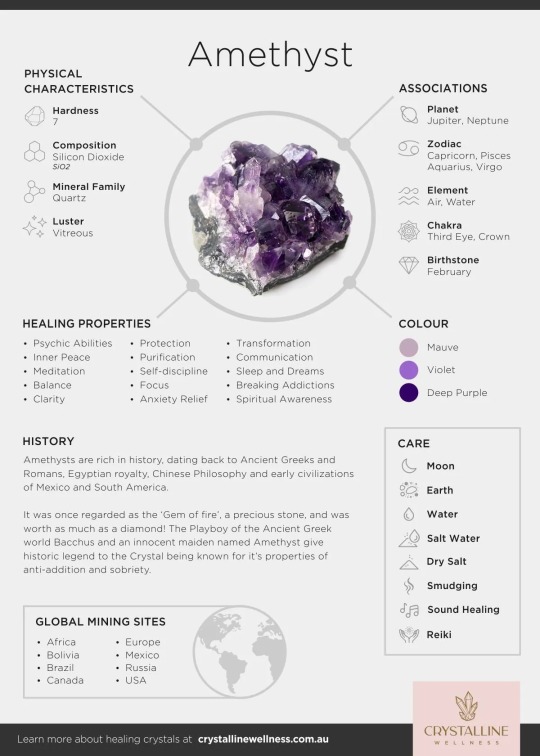






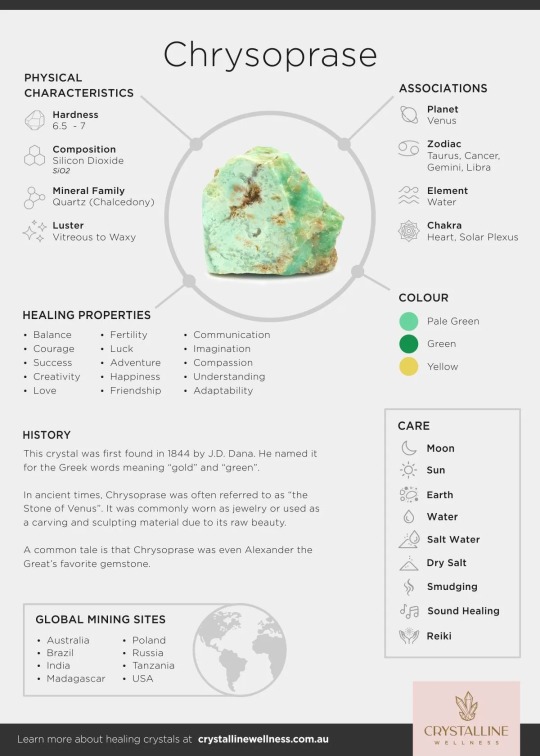

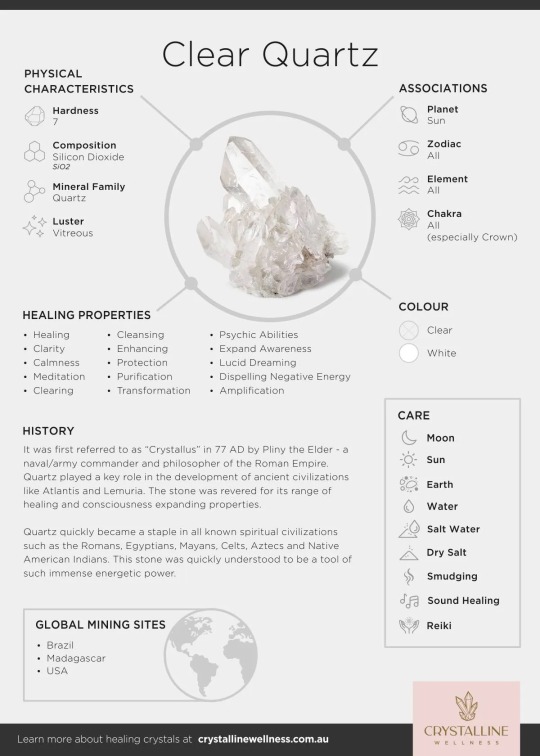
207 notes
·
View notes
Text
Beautifully done crystal infographics. Alphabetical. Part 3.
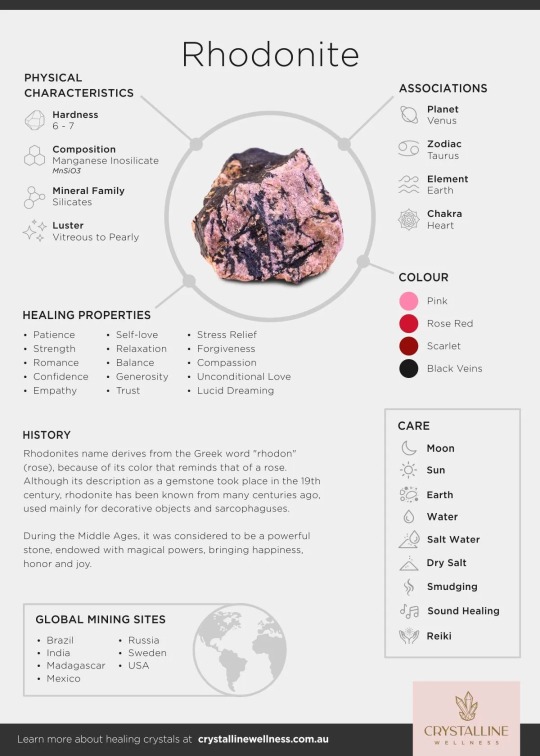
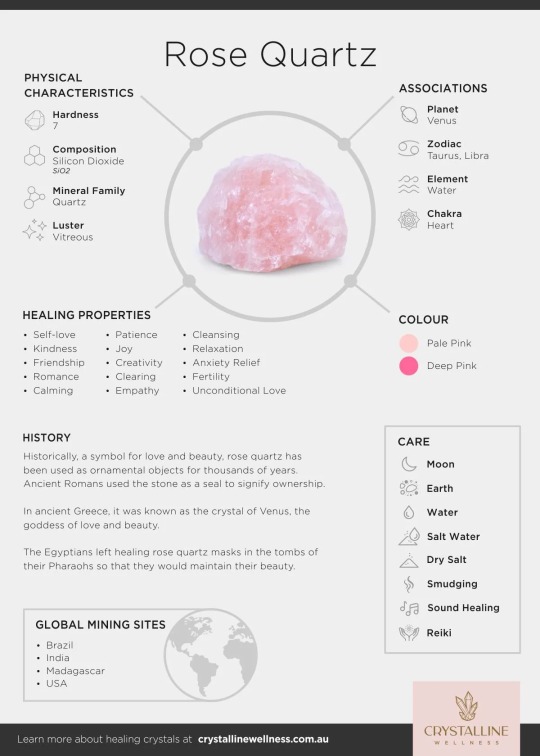
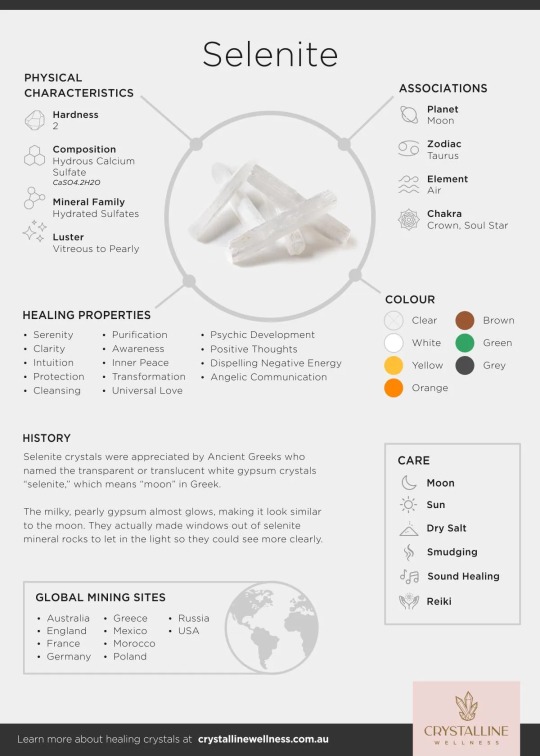

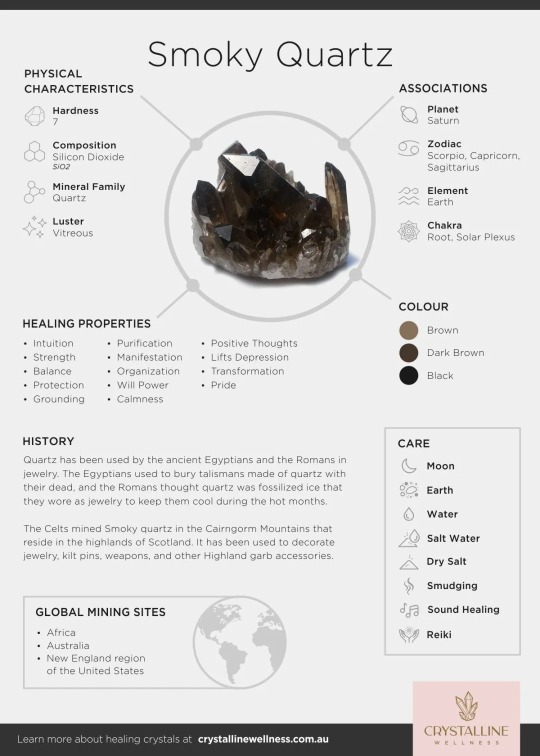
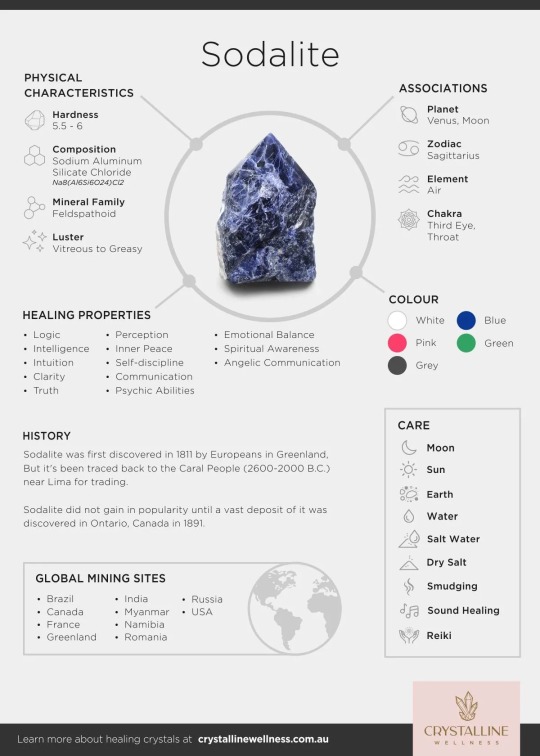
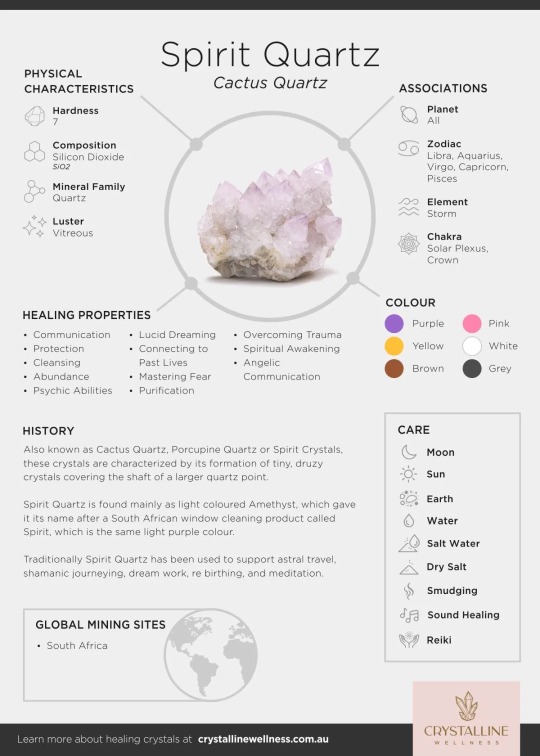
64 notes
·
View notes
Text
Beautifully done crystal infographics. Alphabetical. Part 2.


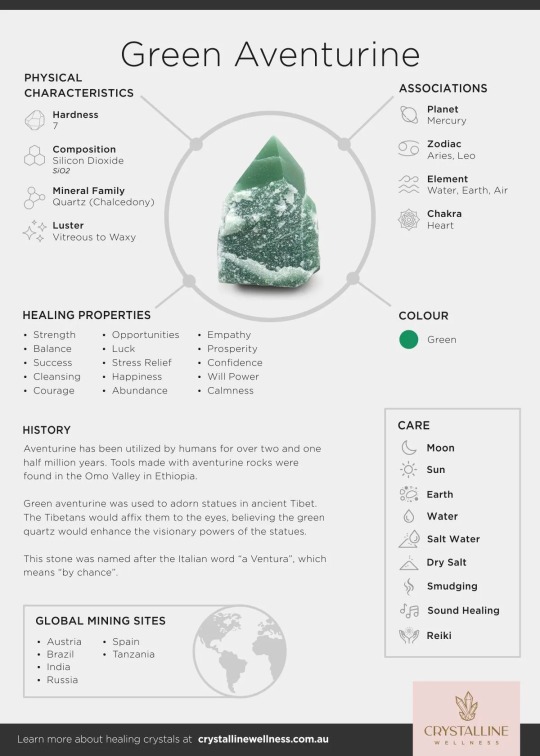
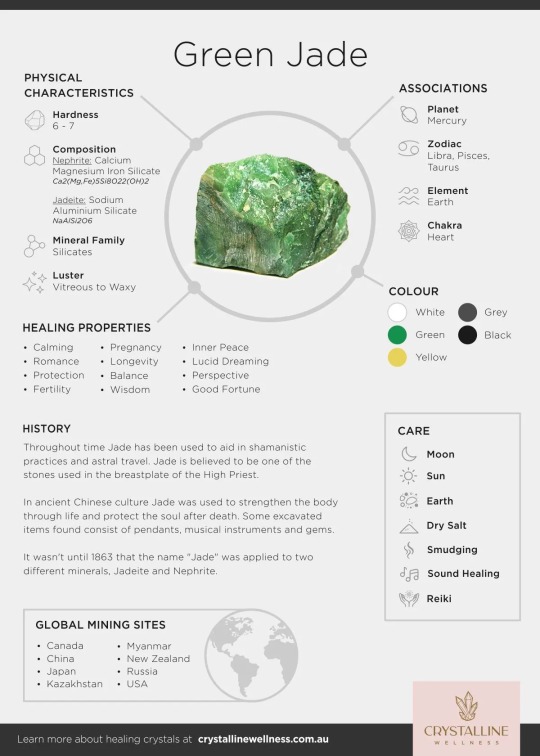

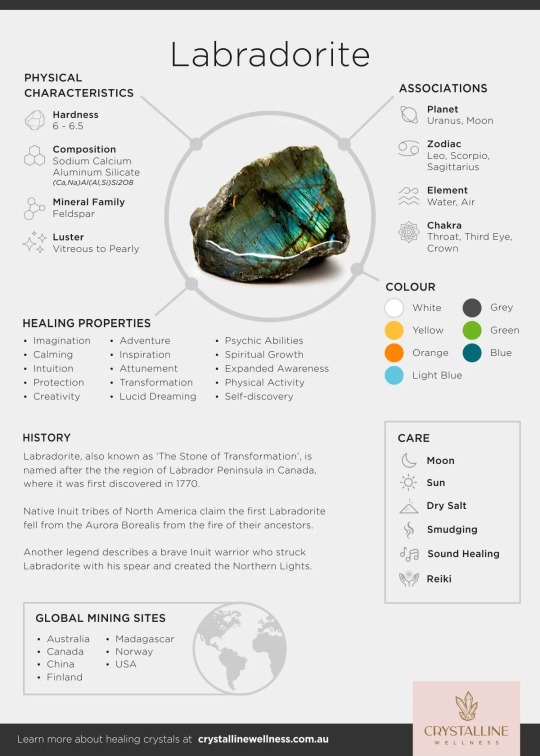

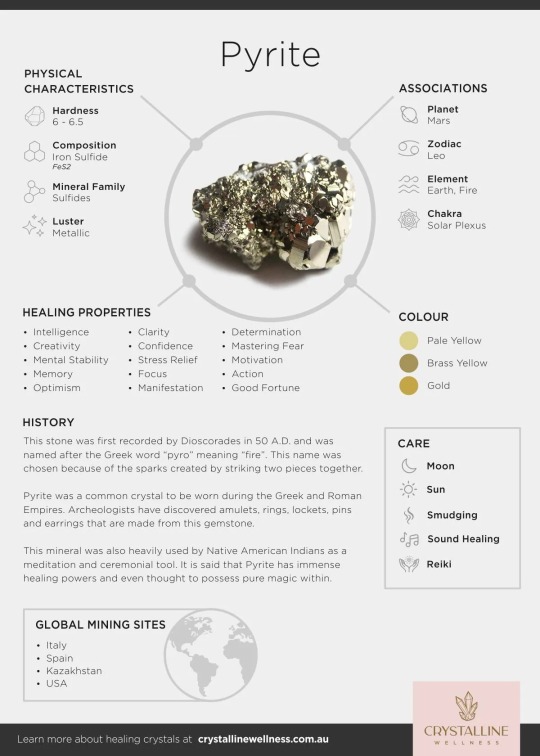


53 notes
·
View notes
Text
common outdoor items & their uses
a guide to common outdoor items and their magickal uses.
acorns- luck, protection, wisdom, power
walnuts- healing, protection, self care
pinecones- fertility, masculinity, growth, nature
pine needles- cleansing, healing, strength, banishment
pecans- employment, protection, success, abundance, prosperity
grass- growth, learning, healing, new beginning, grief, recovery
maple leaves- feminine, travel, change, decisions, healing
oak leaves- truth, justice, knowledge, steadfastness, protection, guidance
birch leaves- protection, cleansing, fertility, purification
dandelions- calling spirits, divination, healing
dandelion seeds- divination, wishes, manifestation, dreams, luck
dandelion leaves- defeating negativity, steadfastness, growth, purification
2 leaf clovers- love, luck, courage, cleansing
3 leaf clovers- protection, luck, fidelity, divination
4 leaf clovers- spirit work, luck, psychic ability, attraction
5+ leaf clovers- wealth, luck, attracting money, sanity
wild clover flowers- animal magick, blessings, breaking curses, luck, love
apple seeds- love, secrets, knowledge, gateways, divination, prosperity
tree bark- protection, binding, banishment, cleansing, purification
rocks- many rocks have crystals hidden inside, the most common is quartz types. if unsure, rockcs can represent strength, stability, protection and banishing. if you suspect its a crystal, look it up and discover the correspondences that matter to you!
will add more as i can, feel free to add your own!!
6K notes
·
View notes
Text

Image Source: The Healing Gem on IG
369 notes
·
View notes
Text
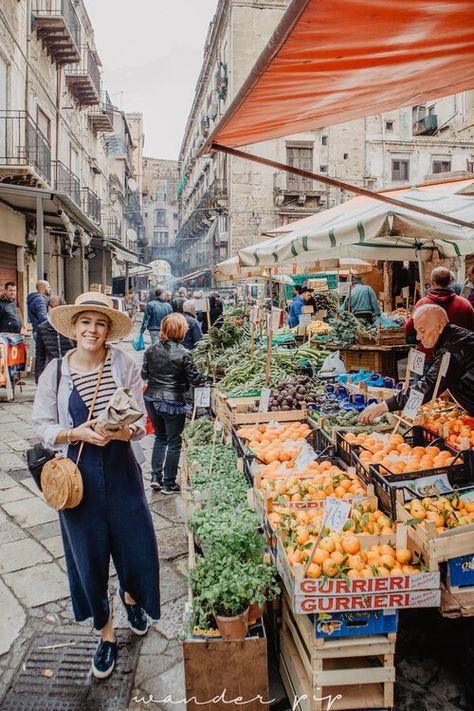


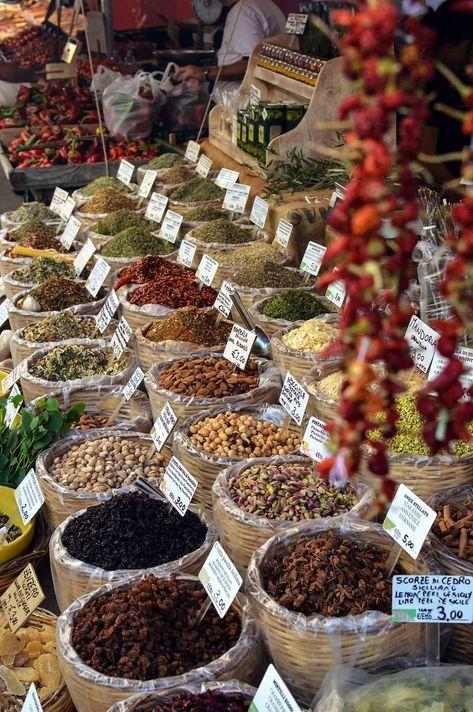
pov: you’re at the Sunday market buying sundresses and crystals and cool trinkets for your house and altar and fresh fruits and vegetables and maybe even a pastry
151 notes
·
View notes
Text

Designing Spells, a how-to guide for every level of experience and discretion: Threshold Theory
Suggested Reading
*-Highly recommended
Threshold Theory*
Path of Least Resistance*
Anchors*
What is Witchcraft?*
Basic Energy Work
Conceptualization Vs. Visualization
Spell Dictation*
Spellcasting Basics*
Basic spell components:
All spells have a few components that are absolutely necessary for potent results. It is going to be assumed that physical and/or energetic work was done to actually prepare and cast the spell.
In order to cast a spell, one needs to be in a space of mind that facilitates the spell working. We often refer to this as ‘Headspace”, this assists one to be more focused. This can be the most difficult aspect of spellworking for some practitioners. The mind needs to be honed in on the spell, the energies, spirits, and intentions involved. This headspace exists to channel the practitioner's focus on the task at hand. This combination of headspace and focus is referred to as a state of gnosis.
Secondly, one would need to have passion, an emotional state that is used to fuel the spell.
Lastly, one needs to have an Intention for a spell. This is the most discussed aspect of spell casting, but is also the most misunderstood. Intention is not to be confused with desire. Intent is a personal truth, something that cannot be lied to. It is possible to cast a spell without one of these three components, however the spell most likely will not be as potent as if one did. You totally can cast spells based on desire and not intent, but validating the spell may be difficult or it may have varied results.
Too read about how to record your spells accurately, check out this post.
Correspondences, Tools, & External resources:
When looking through the internet or other informational resources and/or guides on witchcraft, you’ll probably notice that a few things tend to be regularly occurring:
1. That though a lot of practitioners may say that tools and correspondences aren’t necessary, a vast majority of sources and guides include and/or require correspondences and/or physical tools.
2. The correspondences used in each source are only as common as the dominant source for those correspondences within that specific tradition. For some, those sources are books, and for others they are the first result on a Google search.
When it comes to Tools used to perform magic, there are a few things that must be kept in mind. Some tools are culture/tradition specific and it would be disrespectful for you to use them, which may or may not have spiritual consequences. Many tools are used to accomplish the same ends. For example, wands and athames are used for very similar purposes, the casting and/or projection of energies within a specific space- typically when sanctifying an object or opening/closing a space for a working. If you decide to use a tool for your practice, please be sure that you understand the cultural ramifications of doing so within a spiritual space.
When it comes to Correspondences, there are a plethora of sources that may appear to have contradicting data. This is because they stem from various traditions and sources. This occurs because correspondences are 100% subjective. However, if you practice within a specific tradition or culture, then you are expected to follow the correspondences of that practice. This can be incredibly powerful because people have been building on those ideas and connections for lifetimes.
IF you aren’t a part of a preexisting tradition ask yourself what you feel you should use. Magic can be a very personal and intimate experience. Don’t be afraid to create your own correspondences. Furthermore, don’t be afraid to invent your own tools- but be sure to do so as if it were a sacred act. Magical tools aren’t something that should be thrown together thoughtlessly and then treated like pencils or hair ties, they should be created and treated as what they are: a medium for your magic. They should be planned and made with materials that you deem appropriate. The should be stored as if they were fragile or put on display on an altar. If you’re not open about your practice, this aspect may be challenging to hide.
Types of spells:
In my experience, there are seven types of spells. Please bear in mind that these are by no means finite boundaries for spellwork to exist within, just an acknowledgement of trends.
Altar Spells: Spells that require not only tools and correspondences, but also require a ritual or ceremony in order to cast it. Often, these spells utilize candles and crystals, prayers and symbology, and may even go as far to actually require an altar.
Glamours: These spells more often than not, require only symbols and energy. They are use to altar the perceptions of whatever they’re placed on, whether targeting other or yourself.
Divination: Spells used to heighten your intuition. A lot of practitioners don’t view divinations as being spellwork, but a good diviner uses all three of the basic components of spellwork for their readings.
Psychological Spells: These are spells put on yourself to altar your own mind by manipulating your own subconscious. These spells are performed often through repetitive action and subliminal messaging through turn of phrase of symbology.
Energetic Spells: These spells require only the energies of yourself and/or beings and objects around you. Most energetic spells that are easy to find on the internet are very small spells, typically aimed at small scale manifestation. However, with enough practice and intuition, Energetic Spells can do anything that any other spell type can achieve.
Astral Spells: These are spells that require being in an Astral form or even on the Astral Plane. They are very similar to Energetic spells but they require even less. However, due to the nature of the Astral, maintaining the basic components of spellwork while in this form can be very challenging.
Spirit Spells: These are spells that either use spirits as the medium for the spell to travel through, or employ a spirit to do the spell work for you entirely. Like energetic spells, this type of spell can achieve anything that all the others can if given enough experience and practice.
Spell dictation: Whether it be for recording a spell that you have already cast or recording how to perform a spell you have only just thought of, the way you choose to record your spellwork with have a massive impact on your craft as a whole.
The importance of record keeping:
When performing spells, it is imperative to keep a record of the exact spell process and results. By doing this you’ll be able to keep track of successful spells and those that aren’t. Then it becomes easy to home in on effective spell processes.keeping a record also makes it a lot easier to undo spells that take an undesired turn. I recommend having a dedicated book or Google drive folder to record your spells.
Spell Design Process:
All spells can be thought of as a combination of Thresholds, Nodes, Intent, Focus, and Passion. (And an action)
Without any of these a spell will not function as intended or would not work at all.
Nodes are things like correspondences. They are individual concepts that are connected to form a complete web, or Threshold, for the spell to travel through. Correspondences need not be only for the physical objects involved. They can be as simple as word association or a memory.
Start creating a spell:
1: Decide on a goal, what you wish the spell to accomplish. It is important that your spell takes the path of least resistance in order to have the highest chance at success
2: Create or find correspondences and concepts to create your nodes from and then find how they can be connected. This can be done mentally or by using nodes that are associated with each other.
3: Get all your tools and sympathetic representations together, if you decide to use them. If not, skip to 4.
4: Decide what is the best headspace to be in for casting the spell. It is important to record this as well.
5: Find what is the best emotion to fuel the spell and record that as well.
6: Figure out what energetic programming you wish to use and record that. Do this as best you can, I do realize that the current energetic model definitely leaves a ton to be desired.
7: If you wish to involve spirits, be sure to commune with them beforehand if necessary. And be sure to keep record of the conditions that are reached and which entities you involve.
8: Compile your spell into a single process.
9: Cast and record results.
Be sure to do as much research into your target as possible. Like if you’re casting a spell onto the brain of another person, it would be wise to know their medical history or there could be unwanted side effects.
Discrete Spells and Practices:
The best way to keep your spell work private is to forgo your physical tools and sympathetic representations. This can be achieved by relying on spirit work or energy work.
If you wish to keep the physical aspects of the craft and the way you keep records, I recommend having a small discrete bag to hold your tools and such and coming up with a transcription orthography to write with. This can be either a personal alphabet or a simple encryption like a caesar cipher. A lot of discrete practitioners cannot use candles or burn, in order to get around this you can have ashes as your fire representation and draw things you would burn in water soluble inks. You can also draw Sigils using invisible inks as well.
Networking and How to Talk About Spells:
When discussing witchcraft, it is of the utmost importance to first establish personal semantic meaning. Since witchcraft is a multicultural and multilingual phenomenon, the words used to discuss it vary wildly. This is why I take the time to define my terms.
Once the baseline of semantics has been discussed, it is safe to proceed with discussions about magic. It would be easier to start with practitioners who have a similar practice. But I recommend connecting with anyone who is willing to have fair, free and, open discussions. Remain aware of the nuances of culture as to avoid taking and using what is not meant for you.
Validating Spells:
when recording spells, be sure to note the date and time of casting and have a timeframe in which you would expect a given result. Once the timeline runs its course take any notes of what might be pertinent.
If the spell is continuous, be sure to make note of the situation beforehand so that as time passes you can make notes of relative change.
Sometimes spells don’t work and that’s okay. That just means you need to reassess the working and try again.
Troubleshooting Spells:
If a spell effects more than what was desired, you likely weren’t focused enough or your nodes weren’t connected thoroughly.
If a spell worked but wasn’t to the desired intensity, you likely didn’t fuel it with enough passion during the casting.
If a spell didn’t work at all, it could be that it didn’t take the path of least resistance or you were missing a crucial element. As an example, it is more effective to cast a spell for your employer/client to notice your hard work than it would be to cast one to get a raise.
As you adjust aspects of your working, you’ll be honing it to perfection. Keep track of your changes and overall processes.
If you have any questions, want to know about my blog, commission a Sigil, commission a magical script, suggest content, get a divination reading, or see a list of my planned and published content click here.
1K notes
·
View notes
Text
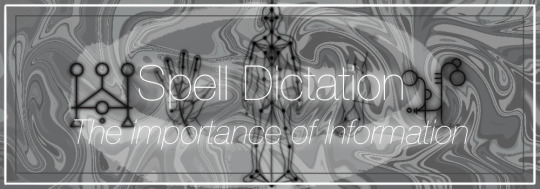
Spell Dictation: Forward
This post is aimed at three target audiences. The first are witchcraft content creators, in the hopes that they will start publishing spells that can accurately be reproduced by their followers. The second are advanced witches, in aims to give them an idea as to what direction they can expand their crafts. The last, and most important are the fledgling witches. Let this post act as a warning and as food for thought about your craft. 100% of the spells you find on the internet do not contain enough information to be accurately reproduced.
Word definitions:
Encryption: the process of converting information or data into a code, especially to prevent unauthorized access
Cipher: a secret or disguised way of writing; a code.
Subtle Body: The energetic system that is constructed of energetic fields, nodes, and conduits that connect them.
Energetic Awareness: The ability to be aware of energetic density, volume, properties, movement, and location.
Energy Point: An energetic node within the Subtle Body
Energetic Gates: An artificial Energy Point that connects a practitioner to a specific source of energy.
Conlang: AKA Constructed language, is a language that is created by one or a few individuals. Sometimes referred to as a fictional language.
Script: A set of symbols used to represent words, concepts, and/or sounds.
Orthography: The graphical representation of sounds, The Latin alphabet is a good example.
Transcription: The act of creating a new script that has a 1:1 representation of each letter in a language’s orthography.
Headspace: The ideal environment and mental state that allows for complete focus on a single task.
What is Spell Dictation?
Spell dictation is how a practitioner describes their spells on paper, digitally, or online. It can range from writing a spell out to having nothing but encrypted graphic representations. This process seems more difficult than it actually is when just starting. In essence, all it really takes is the time to sit and think about what you want to do and how you want to do it. Throughout most of classical magic’s history it was very common to encrypt magical writing. John Dee immediately comes to mind, as he was also the official cryptographer of the queen. As such, all of his occult workings and illustrations were heavily encrypted. Which worked successfully, as many practitioners use his works as they appear, rather than decrypt them. I have made an in depth post about the process of designing a spell here.
Why is Spell Dictation Important?
Being in the proper headspace is so important when casting. For a lot of people, the aesthetics of their spell is just as important for maintaining headspace as music and lighting. Without being in a good headspace the likelihood of your spells working as intended drops significantly. And having a spell that takes up several pages will cause you to break from it and ruin your headspace. If you mark all your pages with significant information, references, symbols, and incantations, then you can check all your sources before casting in order to have a seamless spell process. If you feel that you'll be able to remember every detail about the spells you put into your books, and you don't plant on sharing any online- then just use this post as a guideline for spells you find on the internet.
Necessary Elements of Spell Dictation for Accurate Spell Replication.
In order for your spells to be accurately reproduced by another practitioner it is important to include enough information. There are a lot of variables when it comes to casting a spell and sadly there's almost no modern spell dictations that contain enough information. The important variables to record are:
Subtle body programing/orientation
All possible nodes. (If a memory is a node, it will not translate perfectly for another practitioner.)
Physical objects used and the process of using them
The energetic process throughout the entire spell
The required state of awareness
The variables for building headspace
The center or source of passion
The intent and focus, depicted exactly as it was cast the first time.
Prominent energy points
Energetic current flow and density as it moves through the subtle body and the paths that it takes.
Time and locations, if necessary or desired.
What it targets
How it targets and/or reaches that target
Any spirits used in the spell and their properties and roles in the casting. Potentially even how to summon or commune with them.
Psychic abilities used and how they were implemented specifically, if necessary
Any incantations, their meaning, and any sigils that were used.
Any gestures or bodily movements that were significant.
Any symbols that were used other than sigils
Thorough descriptions of any energetic constructs and thoughtforms used.
Any astral information if necessary.
Any energetic gates used.
As a neat side-effect of densely representing information, your book of spells will be difficult to read without study. This is okay, as you’ll still be able to read it clearly.
The rest of this post is for inspiration and guidance on how to achieve the necessary amount of information.
Concepts for Spell Dictation
An important aspect of thorough spell dictation is being able to fit as much information as possible onto a single page of your medium of choice. This is done by the application of magical scripts, sympathetic notations (symbols that represent a much longer word or sentence), Sigils, Magical symbols, graphical representations, illustrations, encryption, conlangs, allusions to other texts/books, and general clever design.
Using a Magical Script & Conlang for Spell Dictation
Magical scripts are special orthographies used to either write in a conlang or transcribe your chosen language. These scripts can be built on the phonetic sounds of a language or a 1:1 representation of that language's orthography. Doing so does two things at the same time: makes it difficult for others to read your work, which can be perfect for discreet practitioners; and, adds to or improves the general aesthetics of your work. Which can be extremely beneficial; for generating a headspace once you have familiarized yourself with your own methods. Using a conlang can make your spell feel more magical, especially if you design the language yourself and choose what sounds make up your language.
Allusions to Other Texts or Books
You can create a code to reference outside material that takes up very little space on your page. A simple number sequence can be used to describe the page number and line. Or you can create a code specifically for referencing in another one of your books that is dedicated to relevant information like, charts, tables, correspondences, herbs, gestures, etc. This can be done b y assigning each section in that book a letter, and each entry under that section a number. I do this very often in my second and third grimoires. Doing this allows you to include much more relevant information for casting your spell without taking up tons of space on your page.
Magical Symbols, Sigils, & Sympathetic Notation
One of the most common elements found in spellwork are sigils. These symbols pack a lot of information in a relatively small space. And if they’re designed a certain way, they can easily be reproduced from the pages of your grimoire, graphic, or online reliquary. Magical symbols work in much the same way, however they can also be integrated into your conlang or script. Sympathetic notation is when you use pictographs, code words, photographs, or illustrations as representations for magical concepts. These won't be inherently magic, but rather would signify important concepts that are to be considered when casting.
Graphical Representation & Illustration
Graphical representation refers to charts, graphs, and/or tables for important information. As much of magic exists on a spectrum it can be very simple and useful to create graphical representations for many of these concepts, especially if the magical concepts are wordy. Illustrations can work in much the same way as it often takes more space to describe a shape or design rather than just dedicating a small space to draw it out. This is a relatively common practice in online witchcraft communities, though most of which are superficial.
Possible Augmentation of Media
Sometimes, it can be very helpful to notate spells with the music you like to use to cast. The song can be augmented and written in your grimoire to look like song lyrics, alongside a short code to grab bits of information out of the lyrics. This practice can be very useful to discreet witches. The same can also be done with literature, poetry, videos, and movies by notating a time or page along with a code. Sometimes a single quote from a movie can pack a significant punch for the concept you’re trying to capture. Maybe notate the movie or series title with the range of time in which the desired dialog or scene takes place.
Ciphers, Encryption, & Code Words
Sometimes even transcriptions and references aren't enough to protect your information from being read by those that don't have your permission to read it. To solve this issue, you can create an encryption. This can be as simple or as complicated as you’d like. From using conde words to creating a multi-variable cipher wheel. This way, even your transcription wont make sense. Doing so with a magical script would actually add another layer of protection to your encryption. However, doing so can be difficult to use on the fly. The only way it can used once encrypted is to take the time to decrypt your own spell onto a piece of paper or tablet/phone/computer before the spell can be done. I personally only use encryption for my curses and spells that could be dangerous if used by the wrong people or practitioners who dont have enough experience or context to safely cast.
Clever Design
As far as aesthetics and encryption go, you can get very clever with how your information is depicted. There are infinite options for you to choose from when creating your work. One of the biggest elements I would recommend taking into consideration would be continuity of design. If you don’t know where to start when it comes to the aesthetics or designs for your grimoire, I'd recommend starting by watching and reading media about Concepts in Design.
Examples from my own grimoires
The Grey Grimoire
In my first Grimoire I hadn’t really dove into the importance of in-depth spell dictation. The spells in this Grimoire are difficult to reproduce for this reason. I have to remember a lot of the variables involved when I was creating the spells.
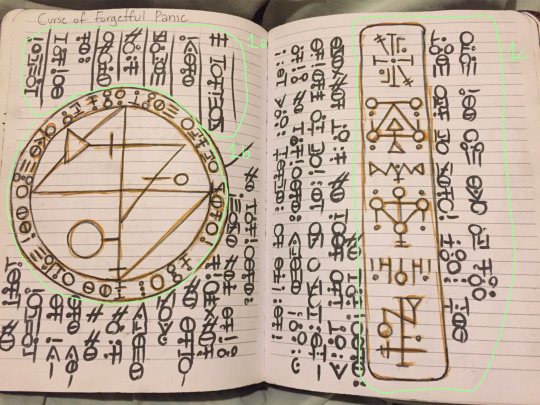
Key:
1a: A list of all the necessary items and tools required for casting.
1b: A spell circle intended to be reproduced for use in the spell and then later burned.
1c: A Sigil-chain and accommodating incantation, intended to be reproduced and burned as part of the spell.
Also, in this Grimoire, I created a complex cipher wheel that is used to decode the Golden Grimoire.
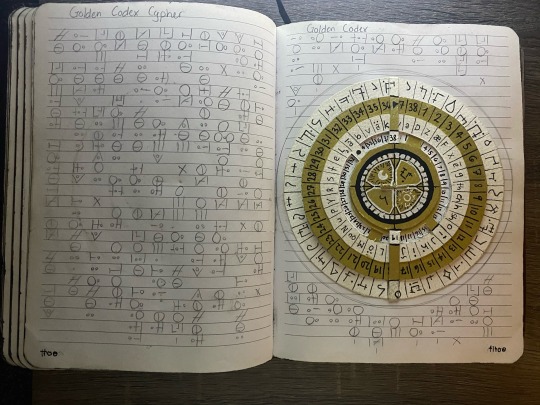
The Golden Grimoire
In my second Grimoire, I started moving away from magic that required physical tools and objects. A majority of the spells in this book are purely gestural and energetic, with a few exceptions. It was here that I began realizing the importance of detailed spell depiction. Unfortunately, I didn’t take into consideration the amount of space all of my reference tables would take up in the book. This Grimoire only has about 12 spells in it as a result.
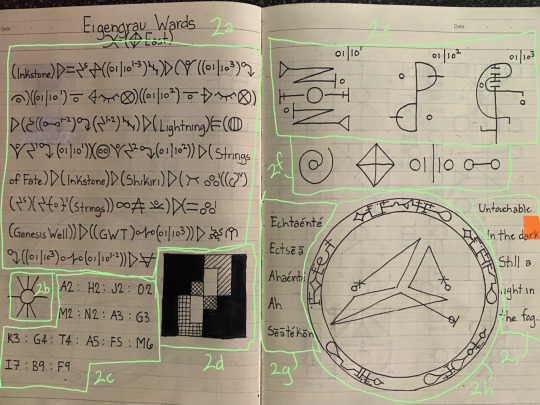
Key:
2a: A pictographic script used to describe both the gesture and energetic process of casting.
2b: A symbol that denotes the level of difficulty for the energy work involved.
2c: References to tables and infographics within the Grimoire.
2d: A 2D topographical graphical representation of how to program the subtle body and the subsequent energetic fields.
2e: The Sigils involved. In this case they are to be reproduced energetically as constructs.
2f: Symbols that are sympathetic notations of important concepts involved in casting such as: Integral energy points, key energetic properties, and what correspondences are the most important to physical use.
2g: The incantation.
2h: What may look like a spell circle, but in actuality it is a graphical depiction of the gestures and stances over time.
2i: A phrase meant to give insight into the mindset required for casting.
The Red Grimoire
In my third Grimoire, which is still very much a work in progress, I applied a lot of what I learned from the prior two about space management and densely recorded information. In this Grimoire, the spells are 100% gesture and energy based and require no physical objects at all whatsoever. Furthermore, the spells in this Grimoire are designed to be modular so that they can be combined to create spells with more specific effects, as each element within each spell is depicted in it’s entirety in terms of energetic programming, mindset, gestures, etc.

Key:
3a: The title of this specific combination of gesture magic and energy work.
3b: A more detailed 2D topographical graphic representation of the subtle body’s programming.
3c: A more refined variation of the pictographic script used to describe the gestures and energy work.
3d: Important information related to the process of preforming this spell-component.
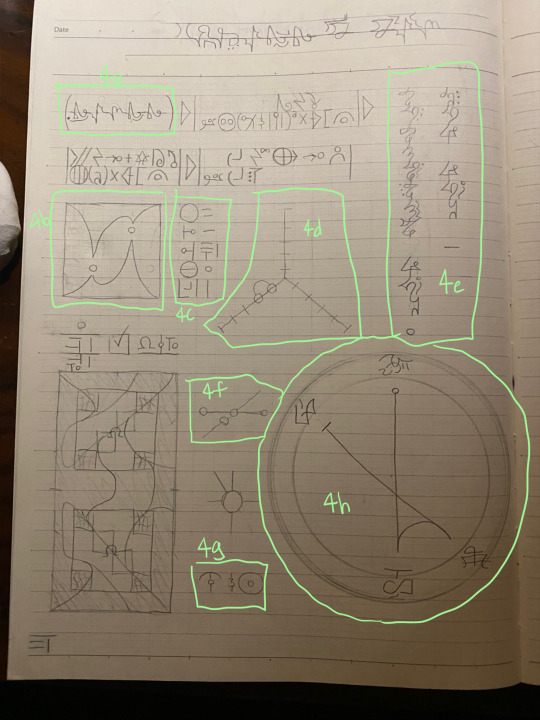
Key:
4a: The beginning of this gesture is notated to begin with the spell-component page above this one.
4b: A graphical representation of the shape of the energetic constructs involved in casting.
4c: References to other books, like the prior two grimoires.
4d: graphical representation of the level and point of focus of Gnosis
4e: Important information required to maintain the proper headspace.
4f: The bodily stance that should be used through the entire series of gestures.
4g: Important Energetic points that should remain in use throughout the entire spell process.
4h: A graphical representation of how the intent and headspace should shift throughout the spell process.
Word definitions:
Encryption: the process of converting information or data into a code, especially to prevent unauthorized access
Cipher: a secret or disguised way of writing; a code.
Subtle Body: The energetic system that is constructed of energetic fields, nodes, and conduits that connect them.
Energetic Awareness: The ability to be aware of energetic density, volume, properties, movement, and location.
Energy Point: An energetic node within the Subtle Body
Energetic Gates: An artificial Energy Point that connects a practitioner to a specific source of energy.
Conlang: AKA Constructed language, is a language that is created by one or a few individuals. Sometimes referred to as a fictional language.
Script: A set of symbols used to represent words, concepts, and/or sounds.
Orthography: The graphical representation of sounds, The Latin alphabet is a good example.
Transcription: The act of creating a new script that has a 1:1 representation of each letter in a language’s orthography.
Headspace: The ideal environment and mental state that allows for complete focus on a single task.
If you have any questions or content suggestions, click here. If you’re brand new to witchcraft, I recommend checking out this post.
#grimoire#advanced magic#advanced witchcraft#informational post#sigils#witchblr#witchcraft#energy work#what a fascinating way of conceptualizing magic. thanks for sharing op#queue
240 notes
·
View notes
Text

Related Reading
Foundations of Energy Work
Intermediate Energy Work
Advanced Energy Work Part I
Axioms of Energy Work
The Subtle Body
Energetic Awareness
Conceptualization Vs Visualization
Path of Least Resistance
Anchoring
Introduction
Like most tools in witchcraft, energetic constructs are tools used to channel, anchor, program, and/or manipulate energy. Constructs can range from simple forms such as spheres or platonic solids to complex forms like a replication of a house or object. The applications of energetic constructs are nearly limitless. Building a construct can be the focal point of a spell or a single component.
What is an energetic construct
Energetic constructs are projections of form in any dimension of space and/or time. The energies used in constructing them are programmed before, during, or after their creation. When a construct is made, its form can either act as conduit or node to the target, or represent the space a spell will occupy. It can be used to modify aspects of the target or space, or as a method of guiding a spell to its desired destination. Constructs can also be used to create wards, thoughtforms, and/or anchors for spells.
Foundations of energetic constructs
All constructs follow the Axioms of Energy Work. There are limitations to what they can and can’t affect. At their core, they are minute manipulations of quanta of information that acts as building blocks for our tangible reality. These manipulations can be programmed and modified to possess their own properties, or designed to influence the properties of the energies it interacts with. Their form can be as important as their programming. If one was to create a ward for their home, it would be more effective to create a perfect energetic replication of the house rather than a simple toroid projection. This can also be aided by symbols/sigils for protection and magically insulative materials such as salt or brick dust. These aids should be considered when a structure is being built, so that they do not interact in unforeseen ways.
Energetic Half-Life
Without anchoring a construct, it will slowly dissipate into the surrounding environment in order to restore equilibrium with the environment. A construct must be tethered to something that is conductive to thermal, electric, or combustion energy; this is to say, that thoroughly binding a construct to a conductive metal such as copper (through thermal or electric conductivity); a piezoelectric crystal such as quartz; or an organism such as a plant that produces energy via a redox reaction. The energy required to sustain a construct is so minute that a piezoelectric crystal is more than sufficient at powering it, even under normal atmospheric pressure.
Anchoring
When anchoring a construct it is important that conduits to it are properly distributed to points of most stress. This can be conceptualized as a hydrodynamic system, in which pressures interact in complex ways. The goal here is to have equal, or desired, distribution of energy throughout the form. By linking energetic conduits, like those within the subtle body, from the anchor to these points of highest stress, the energy produced or conducted to the construct can be distributed as needed.
Spatial Form
When creating a construct that occupies space, it is important to take what ambient energies exist in that space into consideration. If it overlays within physical objects, how will their ambient energies interact with the construct? How can their effects on the construct be mitigated? How can the energies be incorporated into the construct's purpose, if at all? It is rare for an object’s energy to be metastable or inert. While the properties of ambient energies may not affect the construct, they may interact with the anchor.
Temporal Form
When creating a construct that exists through a period of time, it is vitally important that the half-life of the energy is taken into account when choosing an anchor. If an anchor isn’t effective at containing or generating energy, the construct will need to be regularly charged. If the anchor doesn’t generate its own energy, you’ll need to consider how much energy is charged into it in order to sustain the construct for as long as you want it to. If a construct is designed to exist solely through time and not within space, visualization will very likely not be of any assistance. The anchor used to sustain it will need to be static and exist within the same relative frame of reference. This means that if an anchor is used to cast retroactive magic, a form of energetic projection,the anchor for the construct will have to had existed in the same relative location throughout the period of the spells focus in order to be most effective.
Correspondence
Constructs can be used as a correspondence, or node, for a working rather than the working itself so long as it contains the same energetic properties and frequencies as the object, person, location, or idea. However, if a construct is used as a taglock, it is very important to consider the principle of least effort. As the spell may satisfy its intention merely by attaching to the construct.
Projection
Visualization, or imagining, a construct will not give it form or existence. Visualization should merely be used as a mould or blueprint for the construct and nothing more. Projecting a construct can happen a few ways depending on ability and approach. Visualizing and then propagating the construct all at once is possible but can be difficult without practice. Gradually using your energetic body and senses to form each individual aspect of the design is a lot easier for some individuals. Visualization is not required for this process, because energetic senses can be used to feel the form, rather than creating a mental image. It can be helpful to draw a physical blueprint of the construct first. It is also possible to cause a mitosis-like action within your subtle body fields to project a construct. (Size allowing). The density, frequency, and precision are very important to consider when planning a construct as these qualities will have a large impact on the final product.
Multi-Dimensionality
Constructs can be made in more than one dimension of space. This is to mean any number of axises of space that are all separated by 90°. Again, doing this kind of projection can render visualization useless. The benefit of casting into higher spatial dimensions is the level of interaction with other spellwork. In higher dimensions of space, spells cast within two or three dimensions become very easy to avoid as they are like shadows.
To learn more about me as a content creator, commission sigils, commission a script, get a divination reading, or see a list of all my witchcraft related articles, click here!
#energy work#basic energy work#advanced spellcraft#informational post#witchcraft resources#spellwork#magical theory#recommended reading#queue
225 notes
·
View notes
Text
6 Types of Spells:

Which type of spell is your favorite to perform?
Mine is banishing. I use banishing spells a lot for mental health along with protection spells from the negativity leaking in.
I’m also a sucker for Good Luck. I always keep Alfalfa in my cabinet so we don’t go hungry!
Be blessed,
Enchanting Nova
394 notes
·
View notes
Text
Spellsugars

Do you want to make coloured sugars to use in your spellcraft, but don't know how? I experimented, so you don't have to!
Coloured spellsugars can be used in powders, jars, sachets, and since some of them are still food-safe, to put in your tea. I wanted to make a dark blue one for some sweet dreams, pink for self love, gold as a substitute for honey, and green for money/prosperity.
Methods under the cut:
Let me start with the TLDR; imo the best options to colour are food colouring or soft pastels. Food colouring will give you the brightest colours and it will still look like sparkly sugar. Soft pastel will give the most even colour and will be great in powder, but it's harder to get bright colours. Now, onto the long version!
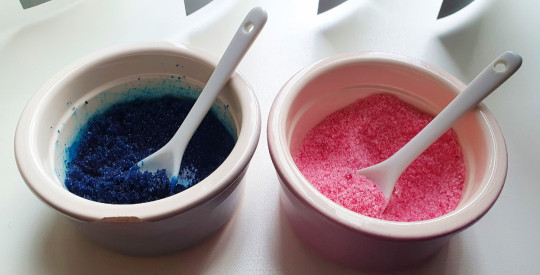
Method one: food colouring. Left is with liquid food colouring, four drops blue and one drop red to get a dark blue colour. Right is gel colouring, in which I used just the tiniest bit. Mix thoroughly! Since this is wet, it needs to dry, either lay it out on a plate and leave it for 24-48 hours or if you have cats like me, make a little plate out of aluminium foil and bake for 10 minutes at 350F. The blue one was a failure, since it turned into a caramel slab that I then had to break apart in the mortar and pestle, meaning it lost a lot of it's colour. But it got a redemption arc! Turns out one drop of colouring was enough (oops) so I mixed the same colour, put one drop in the sugar and repeated the process. Success!
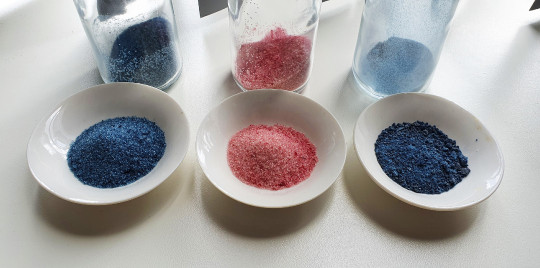
Left: redemption sugar. right: failed sugar.
I love this method because it still looks like sugar, but coloured, which is the effect I want. Also a lot of websites for baking supplies (like wilton) have charts on how to mix alllll the colours, making it extremely versatile
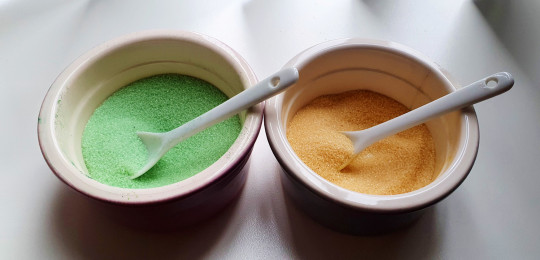
Left, Method two: soft pastel. Take a soft pastel chalk and grate a little into your bowl with a fine grater. Then add sugar and mix thoroughly. I love this method because it gives a very even coat, however it is very hard to get the colours right. I used a bright leafy green, but it came out so soft that I had to add a darker green, and even then it wasn't the colour I wanted. Right, Method three: eyeshadow. Same method as above, except with eyeshadow! (don't use used eyeshadow, that is very much not hygienic). I wanted to try this because I wanted to see if the sugar retains the lustre of the gold eyeshadow. It does not, the spoon and the bottle do, but not the sugar. Also I took as much as I thought I needed, mixed, figured I needed to triple that to get any sort of colour. So this just isn't worth it.
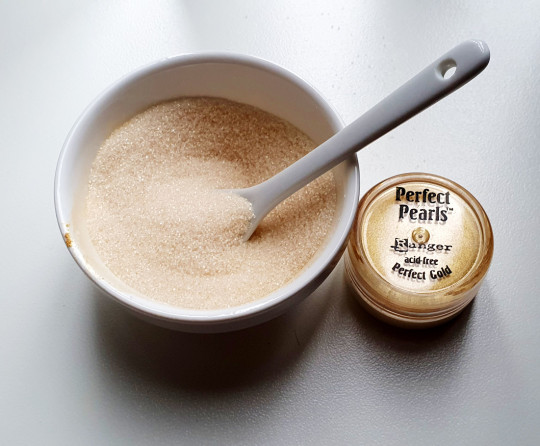
Method four: perfect pearls, or other crafting powder. Put a little bit into your bowl, mix thoroughly. Again, I was hoping that it would retain the lustre, but it didn't. And I ran into the same problem as with the eyeshadow, I would need a lot just to get a bit of colour.
So, for brightness, and edibility, use the (liquid) food colouring. For softness, use soft pastels. Happy crafting!
Also tagging @breelandwalker because I saw in her powders tag that people were asking how to make black sugar, which got me off my ass to finally try this.
272 notes
·
View notes
Text
How to make them shut the fuck up
Do you live with mormons
Do you live with mormons while you're trans
Do you live with mormons while you're trans while you practice witchcraft
If you answered yes to at least one of these three questions, oh boy do I have the spell for you. I call it the Just Shut Your Sour Ass Up spell. It works great. Spite fuels this spell. Make sure you're spiteful. Are you spiteful yet? No? Think of that one particular uncle who drives the god damn truck and wears the red hat. You know the one. Mad? Yeah? Good.
You'll need:
A lemon
Sea salt
Water
Needle and strong thread (preferably black)
Scrap of paper
Red pen/pencil (bonus spite points if you use a bible pencil)
Spite.
More spite.
Bigot family: optional.
Instructions:
Go grab a lemon.
Put some salt in a bowl. Or a cup. Whatever.
Add moon water. Actually, tap water, as they don't deserve your moon water.
Scrub the lemon with your salty paste. Yes, your cuticles will hate you. Just put some lotion on after washing your hands. Seriously. You'll want to.
Take the meanest knife you own (you know the one) and give that lemon a big fucking stab wound. Just one, so make it ANGRY. Think about how fucking DONE you are will all this bullshit. Oh my god. Fuck this. HHHUUUUUGGGHH. I hate this shit so much just leave me the hell a l o n e. Put knife away.
Grab your paper and red writing utensil. Write "Insert name; shut your sour fucking mouth."
Fold up paper
Shove paper into lemon with as much spite and anger as you can muster after that stabbing.
Stitch shut.
Chuck it in a drawer or something idfc just put it somewhere they won't get it.
Go cool off because jesus fucking christ you're pissed.
And now they'll shut the fuck up and leave you alone about your identities. Whoop de doo. Avoid them like the plague at thanksgiving dinner you're forced to attend and try not to throw salt in their cake slice.
Good luck
Tips and Commissions for a witch who wants to move out of a Mormon house so they can have two seconds of goddamn peace: Ko-Fi
#witchcraft#kitchen witch#green witch#magic#green magic#witch#witchblr#herbal magic#witch tips#grimoire#queue
1K notes
·
View notes
